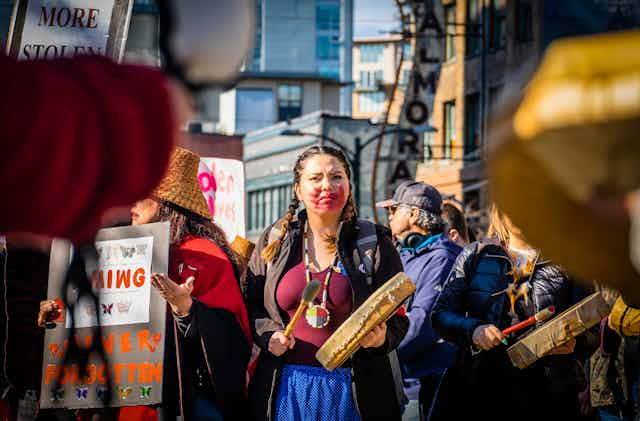The recent controversy surrounding Mary Ellen Turpel-Lafond’s claims of being Indigenous has once again shone a spotlight on the issue of “pretendians” — people who have obtained privileged positions through false claims of indigeneity.
It also points to the way Indigenous women’s identities have been determined by men throughout most of Canada’s history.
In response to the CBC report that cast doubt on Turpel-Lafond’s claims, male-dominated organizations such as the Union of British Columbia Indian Chiefs, the Federation of Sovereign Indian Nations, the Saskatoon Tribal Council and Snuneymuxw First Nation came out in support of Turpel-Lafond.
However, the response from Indigenous women has been vastly different. Many prominent Indigenous women do not support Turpel-Lafond’s claim.

Women like Cindy Blackstock, who has worked with the community claimed by Turpel-Lafond. Vice-Chief Aly Bear from the Federation of Sovereign Indian Nations retracted her support after evidence came to light. Native Studies professor Kim Tallbear said she no longer believes Turpel-Lafond is Indigenous. And the Indigenous Women’s Collective is calling for the revocation of her honorary degrees.
To understand these differing responses we need to go back to the gender discrimination of the Indian Act.
What is coverture?
Since its implementation in 1876, the act created a system where Indian men were the focal point for determining Indian status. The justification for placing Indigenous men in this role was the British doctrine of coverture.
Much has been said about the legal fictions that formed the foundation of colonialism, like the doctrine of discovery and terra nullius. However, coverture and the resulting entrenchment of patriarchy within Indigenous communities does not get as much attention.
With coverture, a married woman is not viewed as a separate legal entity from her husband. This doctrine, developed in England, was brought to Canada with colonization and was used to prevent women from being recognized as persons, holding property, testifying against her husband, voting or passing on Indian status to their spouses or children.

Coverture in the Indian Act
While coverture ended in England in the 19th century, and was gradually eroded in mainstream Canadian society, it remained embedded in the status provisions of the Indian Act.
When the Indian Act was first passed in 1876, people who qualified for Indian status were those who were:
- An Indian male.
- Children of an Indian male.
- A woman married to an Indian male.
This meant that a European woman who married an Indian man could gain Indian status, as would any children she bore while married to him. However, an Indian woman who married a European man lost her status and she and her children were viewed as white. This change in status meant many Indigenous women were forced off reserves and away from their communities.
The inability of Indigenous women to keep their status after marriage only ended after decades of legal struggles by women like Sandra Lovelace Nicholas, Jeannette Corbiere Lavell, Yvonne Bedard and Sharon McIvor.
The passing of Bill C-31 in 1985 enabled Indigenous women to regain their Indian status and keep it upon marriage to a non-Indigenous man. But they were still not able to pass full status on to their children the way that Indigenous men could.
Today, their descendants are still being discriminated against. Unlike Indigenous men, Indigenous women have never been able to pass Indian status to their spouses.

Struggle for equality
While Indigenous women were fighting for equality in status under the Indian Act, advancements towards self-governance were being made with the inclusion of Aboriginal rights in the Constitution. However, male-dominated organizations such as the National Indian Brotherhood, the precursor to the Assembly of First Nations, took the lead in constitutional amendments, to the exclusion of Indigenous women.
Discrimination continued through backlash and fear that Indian women who might want to return home would place strain on limited resources. Many First Nations established criteria that prevented the women and their descendants from becoming full members in their communities, entitled to the same benefits and privileges that Indigenous men and their descendants have always had.
This has led to disadvantage and extreme hardship, as outlined in the report of the National Inquiry into Murdered and Missing Indigenous Women and Girls.

Indigenous women and their supporters have proposed changes to the Indian Act that would neutralize the legacy of coverture by making all Indians equal. These changes did not receive sufficient support to be implemented. There has been no national campaign to allow spouses of Indigenous people to gain status under the Indian Act.
These types of issues, which are central to the advancement of self-government should be decided by nations with the full participation of Indigenous women. Instead, self-governance work often progresses without addressing the history of gender discrimination.
Discussions about the source of Indigenous identity must take place with the full involvement of Indigenous women. The history of coverture and unresolved gender discrimination must be considered when considering false claims of indigeneity. In academia, those making the false claims tend to be female, and it is Indigenous women who they are displacing.

